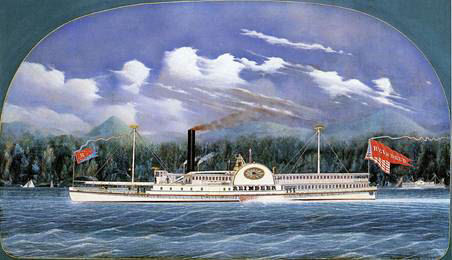Hawesville
Virginia native Richard Hawes provided the land for which the county seat of Hawesville was formed. The first post office opened in this city in 1830 and the town was incorporated in 1836.

Virginia native Richard Hawes provided the land for which the county seat of Hawesville was formed. The first post office opened in this city in 1830 and the town was incorporated in 1836.

From the early days of settlement, the Ohio River was the center of commerce in Hawesville. Steamboat construction flourished along the riverfront and a thriving coal mining industry made the town one of the chief refueling points on the river. Hawesville even produced several men who became famous for their exploits on the river: John Cannon, the famous riverboat builder and captain, was born in 1820 on a farm near the Ohio River upstream from Hawesville. His fastest boat, the Robert E. Lee, defeated the Natchez, July 4th 1870, in the most heralded steamboat race ever held in America. While operating the H&C ferry, Captain W.D. Crammond built four steamboats in Hawesville and ran a packet service on the river. Arthur Rees of Hawesville was an engineer on many Ohio River steamboats, including the Belle of Louisville. Residents in Kentucky and Indiana crossed the river on the Hawesville ferry, opened in 1831 by the Hawes family. John Crammond leased the ferry rights in 1892. J.W. Pate of Cloverport ran it during the 1920's and Earl Bettinger of Tell City assumed operation in the 1930's. The ferry known as the H&C (Hawesville and Cannelton) became the largest ferry operation in Kentucky before it shut down in 1966, when the Lincoln Trail Bridge opened.

During the Civil War, Hawesville was a citadel of Confederate sympathy and became a refuge for rebel guerrillas. Conditions in the town reached an explosive stage by the summer of 1864. Guerrillas had blasted the entrances of several Reverdy Coal Co. mines that were supplying fuel to Union steamboats. The Indiana militia had pickets posted along the Indiana shore from the east and west borders of Perry County, waiting for a possible guerrilla crossing. Tired of the guerrilla nuisance, Captain Edmond Morgan moved his iron plated steamer Springfield into position and opened fire on Hawesville July 25th, 1864. As the shells fell, startled Hawesville residents ran for cover in the stonewalled Catholic Church or ducked inside the coal mines at the west end of town. Union cannons on the Cannelton shore and other gunboats also fired frequently on Hawesville. The Presbyterian Manse, which still stands, was one of the structures hit by Union shells during the war, and is now owned by Mr. & Mrs. Rick Montague. Hawesville was the birthplace of William Davison, a Confederate guerrilla captain and son of Dr. Hardin Davison. Davison's band of marauders terrorized civilians in the river counties of western Kentucky in 1864. Davison died in 1865 from wounds suffered while he was burning the Owensboro-Daviess County Courthouse. He was buried in a shallow grave in southern Hancock County and was moved to the Hawesville Cemetery after the war.

Memory Gardens Cemetery is burial place for thirty-eight passengers of steamboat Reindeer who were killed when a boiler exploded on the Ohio River between Cannelton, Indiana, and Hawesville, March 13, 1854. A gravestone on the northeast edge marks the location where the victims were buried in a mass grave. Pictures of steamboats in the Hancock County Museum were donated by Arthur and Dorothy Reese. Their Daughter Peggy Bastin lives in Owensboro and is still active in helping with the museum. In the museum they have the official Hat worn by Arthur Reese who was the steam engineer on the Belle of Louisville which is still in operation today. The Reese family used to live in the house right next to the current Hawesville City Hall. The museum used to be used as the old city hall. They changed the inside to tiling on the floor and paneling on the walls but when turning it back into a museum they restored it back to the original floor and walls. The Steamboat room is located in what used to be the ticket room in the old train station. The Gertrude & Judelle were steamboats actually built on the banks of Hawesville The Sprague was the largest paddle wheel boat ever to float down the Ohio River H & C Ferry served as transportation between Hawesville and Cannelton up until the mid 1930’s. Mail & Merchandise came from steamboats. Replicas of many steamboats are located in the museum an were built by Franklin Meserve. The museum has been operating for 24 years and it full of the history of Hawesville

In the mid-19th century, jobs in the coal mines in Hawesville attracted workers from as far away as England, Ireland, and Germany. During the boom atmosphere Hawesville was a wide open river town known for the best saloons and gambling games in the region. Disputes were often settled with guns, knives, and fists. Main Street in front of the courthouse in Hawesville was the scene of one of the most widely publicized gunfights in Kentucky before the Civil War. In March 1859, a shootout between factions led by merchant Thomas St. Clair Lowe and district prosecutor Cicero Maxwell, left one man dead and two wounded, and was publicized nationally in the well-known newspaper Harper's Weekly. In the aftermath of the fight, Hawesville physician Hardin Davison fatally shot Lowe in the city jail as he was awaiting trial. Lawmen in the town declined to charge Davison with a crime. In February 1860, Dr. Davison was involved in another act of violence in downtown Hawesville. He walked into Charles B. Duncan's Store (now the site of the Hawes building) and detonated a home-made bomb, attempting to kill William Sterett, a Hawesville lawyer who had denounced Davidson's unpunished killing of Lowe. The doctor, who lived on old Clay Street near the riverfront, died from burns and injuries sustained in the explosion.
